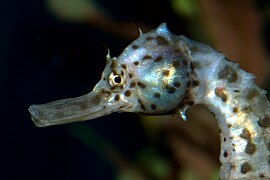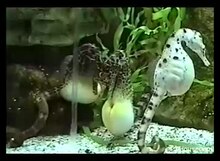Potbellied seahorses
| Potbellied seahorses | ||||||||||||
|---|---|---|---|---|---|---|---|---|---|---|---|---|

Pot belly seahorse ( Hippocampus abdominalis ) |
||||||||||||
| Systematics | ||||||||||||
|
||||||||||||
| Scientific name | ||||||||||||
| Hippocampus abdominalis | ||||||||||||
| Lesson , 1827 |
The fat-bellied seahorse ( Hippocampus abdominalis ) is one of the largest species in the seahorse genus and lives in the waters of southeast Australia and throughout New Zealand . According to the IUCN , this animal is not at risk .
features
With a length of up to 35 centimeters, the fat-bellied seahorse is the largest seahorse in Australia and thus one of the largest representatives of the seahorse genus. On average, they reach a length of around 18 centimeters. As with other seahorses, the rather small head, which is reminiscent of a horse's head, is held at right angles to the slender body, the eyes can move independently of each other and the tail can clasp objects. They have a moderately long snout. It has a deep, triangular crown and rounded bumps over the eyes. Instead of scales, as is common with most other fish, they have bone plates arranged in a ring around the body. A total of 12 to 13 bone rings are formed in this way. Swimming is made possible by their rapidly oscillating dorsal fin; to steer you can use each fin separately. In contrast to most seahorse species, the fat-bellied seahorse is a relatively active swimmer and swims up to several hundred meters in the course of a day. This species has a large, swollen belly, especially males. As with most other seahorse species, the fat-bellied seahorse is well camouflaged. Individuals can be brown, yellow, gray, white, orange, marked with dark spots on the head and trunk. Their tail often has alternating light and dark stripes. Males differ from females in that they have a longer tail, a shorter, more robust snout, and more dark markings. They also typically have a yellow mark near the top of the incubator pouch.
Occurrence
Hippocampus abdominalis is found in the marine waters of southeast Australia and throughout New Zealand . In Australia, the species occurs from the Great Australian Bight to Newcastle and in the waters of Tasmania .
Habitat
Hippocampus abdominalis has been sighted in harbors, sheltered coastal bays, and deep waters near sponges. They can be found under algae, seaweed, and around rocky reefs in relatively shallow water. In deeper water they typically stick to sponges. The depth range varies considerably from the surface of the water to a depth of 104 meters. The habitat of the animals also varies from intertidal zones to underground rock formations, exposed open seabed and man-made structures. In Tasmania, they have been reported to roam near large estuaries on muddy bottoms or near reef edges. They occur at water temperatures of 8 to 24 ° C and die at temperatures above 26 ° C. It is not definitely known whether they occupy home areas or whether they are free to spread, although there is some evidence that certain populations may exhibit site fidelity. Artificial structures seem to be an important living space, especially footbridges, nets and salmon cages. For example, hundreds of individuals have been observed on robber nets surrounding salmon aquaculture pens in the Huon Estuary in Tasmania. Similarly, H. abdominalis has been observed in reasonable numbers on the net of a swimming enclosure in Sydney Harbor since 2003 .
Way of life
This seahorse is a stalker , it feeds on plankton in the wild . By folding down the lower jaw, the fat-bellied seahorse can create a strong suction and thus pulls its prey into its tubular mouth.
Natural predators include fish such as rays ( Dipturus ), deep-sea cod ( Pseudophycis bachus ), trumpet perch ( Latris lineata ), sand perch ( Parapercis colias ), kingklip ( Genypterus blacodes ), red sea bass, and wrasse ( Notolabrus fucicola ). In Australia also flatheads , the striped frogfish and birds like cormorants . They are also hunted by little penguins .
It is reported that this species is more active at dusk and at night than during the day. In New Zealand (Pa. In Australia, H. abdominalis has been observed to accumulate in groups at night).
Reproduction
Potbellied seahorses are, for the most part, monogamous , oviparous, and reproduce year-round, with a peak in the warmer months. The females produce the eggs and use them to create quite a large supply of yolks. As with other seahorses, this species shows a pronounced courtship behavior. Male specimens repeatedly inflate their pouches with water to induce females to lay their eggs in it. When inflated, the bag turns lighter in color and appears whitish. The whole body is also discolored more intensely. When males find their preferred female, they twitch their heads down and flutter their dorsal fins. When the chosen female reacts to this, spots and stripes become more contrasting and she twitches her head up. Then they wrap their tails around each other and swim to the surface of the water. During the following sexual act, the female swims directly in front of and slightly above the male, pressing her stomach against the male's pouch and injecting her eggs into its opening. In this way, around 300 to 500 eggs are injected into the belly pocket, where they are fertilized by the male sperm. The males then provide physical protection for the developing embryos. Spawning occurs from October to January. Young fish are born after a gestation period of around 4 weeks. During the summer, the males breed up to four times. According to reports from an Australian breeding station, a male seahorse gave birth to 1,116 cubs.
The newborns are slender, 15 to 21 millimeters long, with a relatively straight body at birth that tilts to adult shape within a day or two. According to this, the young animals are morphologically similar to the adults. They have spines of moderate length along the trunk and the front base of the tail. Immediately after emerging from the bag, the young fish rise to the surface and cling to each other and float in the water with their prehensile tails. Occasionally they hold onto objects that are floating. They are then independent and start eating.
threat
Hippocampus abdominalis is threatened by localized habitat loss and degradation from coastal development and from being caught as bycatch in bottom trawling. However, it is believed that bycatch levels are low. These animals are rarely traded, mostly as curiosities or in the aquarium trade. When dried, these animals are used as medicinal products in traditional Chinese medicine .
The entire genus Hippocampus was listed in Appendix II of the Washington Convention on the Protection of Species in November 2002 , which means that commercial trade is possible after a safety assessment by the exporting country.
attitude
In principle, the holding of hippocampus abdominalis is notifiable and it is important to pay attention to the relevant evidence when purchasing. Furthermore, keeping these seahorses is demanding and should therefore only be considered by experts.
The aquarium in which pot-bellied seahorses are kept should offer the animal many opportunities to hold onto objects or plants with their tails, or to clasp them. Options include caulerpa, horn corals, soft corals or fine ceramics. Stinging corals should be avoided because of the stinging poison, and the tank should be higher than 50 centimeters and the current speed should be low. The seahorse should be fed four to six times a day, so you should pay attention to a powerful skimmer .
supporting documents
- ↑ a b c d e f g Hippocampus abdominalis in the Red List of Threatened Species of the IUCN 2017. Posted by: Pollom, R., 19 August 2016.
- ↑ Hippocampus abdomialis on Fishbase.org (English)
- ↑ a b c d e Dianne J. Bray: Bigbelly Seahorse, Hippocampus abdominalis Lesson 1827. Fishes of Australia, accessed on September 23, 2018 (English).
- ↑ a b c d e f fat-bellied seahorse (Hippocampus abdominalis). WESO Software GmbH, accessed on January 7, 2019 .
- ↑ a b c d Big-belly seahorse. (No longer available online.) Wildscreen Arkive, archived from the original on January 10, 2019 ; accessed on January 7, 2019 (English). Info: The archive link was inserted automatically and has not yet been checked. Please check the original and archive link according to the instructions and then remove this notice.
- ^ R. Hawkins, Seahorse Australia , Tasmania, Australia, in a correspondence with S. Foster, June 12, 2003, cited in: Sara A. Lourie, Sarah J. Foster, Ernest WT Cooper, Amanda CJ Vincent: A Guide to the Identification of Seahorses . Project Seahorse and TRAFFIC North America, March 2004, p. 23, ISBN 0-89164-169-6 .
Web links
- Hippocampus abdominalis on Fishbase.org (English)





